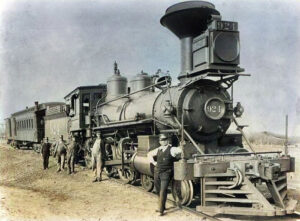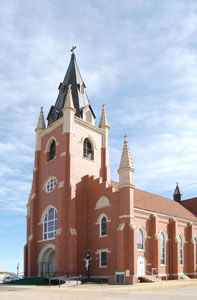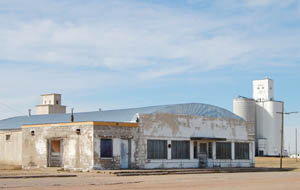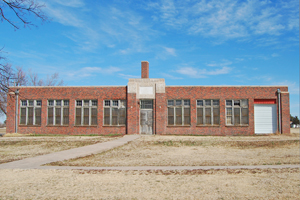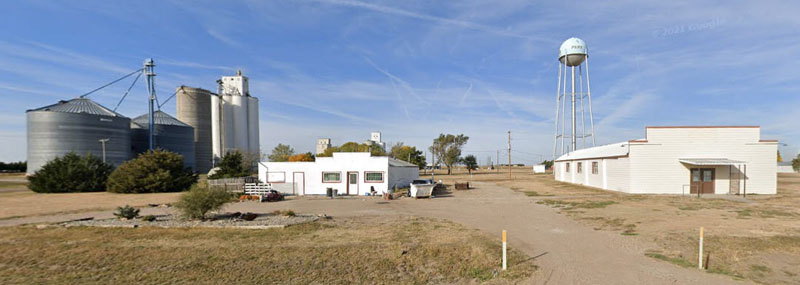
Main Street buildings in Park, Kansas, courtesy of Google Maps.
Park, Kansas, is a tiny town in Payne Township of Gove County. As of the 2020 census, the population of the city was 112, and it has a total area of 0.32 square miles, all land.
The oldest community in the county, this place began as a station on the Kansas division of the Union Pacific Railroad. The station, known as “Buffalo Station,” was established in 1868. English and Irish immigrants founded Park.
William (Billy) Sternberg became the agent at Buffalo Station because of his ability with a telegraph and his promise to stay for three and a half years.
When a post office was established on August 19, 1873, it was called Hill Gove and became a mail and trade station between Denver, Colorado, and Salina, Kansas.
The Buffalo Town Company was formed on February 2, 1878. Buffalo was the first platted townsite in Gove County. That year, the town formed the first school district in Gove County. Among the settlers who came to the Buffalo Park area in 1878 were German-speaking Dutch from Pennsylvania.
The town’s name was changed to Buffalo Park on April 28, 1879.
In 1880, the second newspaper in Gove County, The Express, was established in Buffalo Park. In June of 1880. The Express stated that by the end of 1879, Buffalo Park had 12 stores, three hotels, three livery stables, three restaurants, three saloons, a barbershop, two blacksmith shops, a harness maker, a bakery, a newspaper, and a physician/surgeon.
The first church in Buffalo Park was a Congregational Church built around 1880.
The Buffalo Park Pioneer newspaper replaced The Express in 1885.
In 1885, Buffalo Park was still on the Kansas division of the United Pacific Railroad. At that time, it had a Congregational Church, a district school, a general store, a hotel, a livery, a meat market, a grocery store, a hardware store, a blacksmith, two creameries, and a population of 100. Livestock was its principal shipment, and stagecoaches ran daily to Oberlin, from which the mail was delivered to L.J. Bliss, the postmaster. Stage coaches also ran to Ness City and Millbrook twice a week.
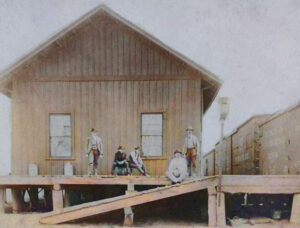
Union Pacific Railroad Depot in Park, Kansas.
By 1886, Buffalo Park stood a fair chance of being named the county seat. The permanency election was held in October, and Buffalo Park, Gove, Grainfield, and Jerome would all submit their names for consideration on the ballot. Various offers were made to entice county electors. For example, the Bank of Grainfield announced that it would provide the county commissioners with $7,200 for the erection of a courthouse and new recording materials. Gove offered the use of the 1885 Benson House Hotel as the county’s courthouse.
The small town of Jerome, realizing its efforts to gain the county seat were futile, ultimately placed its backing behind Gove. The competition in Gove County was relatively mild compared to several other counties in western Kansas. The election results went in favor of Gove, who received 480 votes. Buffalo Park received 218 votes, Grainfield 174, and Jerome one. The winner was accepted without question or litigation, and the Benson House on Broad Street in Gove became the county’s courthouse.
In May 1886, the Buffalo Park Pioneer listed numerous businesses, which included: Buffalo Meat Market, Buffalo Hotel, Real Estate, General Store, Fancy Boot and Shoemaker, Hay, Feed and Grain, and G.A.R. Post 367. In 1889, the G.A.R. Memorial College of Buffalo Park was chartered by the state as a college for children of Union Soldiers.
In 1889, the first Catholic Church was built.
In 1894, Buffalo Park was still on the Union Pacific Railroad and the stagecoach line to Tiffany, 13 miles distant. At that time, it had two liveries, a hotel, a nurseryman, a creamery, a grocery, a shoemaker, several men raising livestock, and a population of 150. It was five miles from Grainfield, the nearest banking point.
The city was renamed Park on February 25, 1895.
From 1896 to 1901, the Catholic Fathers provided weekday celebration of Mass in private homes.
During 1899 and the spring of 1900, the first Catholic church building, measuring 30 x 60 feet, was constructed. The frame building was erected on the southwest corner of block twelve by Mr. B. Albers of Angelus with his son and brother-in-law assisting him. In 1901, on the patronal feast of the Sacred Heart of Jesus, the church was dedicated.
Beginning around 1900, the Volga-Germans from western Russia began immigrating to the Buffalo Park area in large numbers.
In 1909, the church was extended 20 feet, and a steeple was added.
In 1910, the town had an express office, a money order post office with one rural route, two grain elevators, half a dozen stores, and a population of 60.
The cornerstone for a new Sacred Heart Catholic Church building was laid on October 25, and the new structure was dedicated on August 23. The new church measures 150 x 60 feet with an extension on each side of the transept of 10½ feet. The old church was sold and later torn down.
Park’s population peaked in 1950 at 223.
Today, Park’s students are served by USD 292, Wheatland, Kansas.
Park is located 13 miles northeast of Gove, the county seat.
©Kathy Alexander/Legends of Kansas, updated July 2025.
Also See:
Sources:
1884-1885 Gazetteer and Business Directory, R.L. Polk & Co.
1894 Gazetteer and Business Directory, R.L. Polk & Co.
Blackmar, Frank W.; Kansas: A Cyclopedia of State History, Vol I; Standard Publishing Company, Chicago, IL 1912.
Fort Hays University
Volga German Institute
Wikipedia

